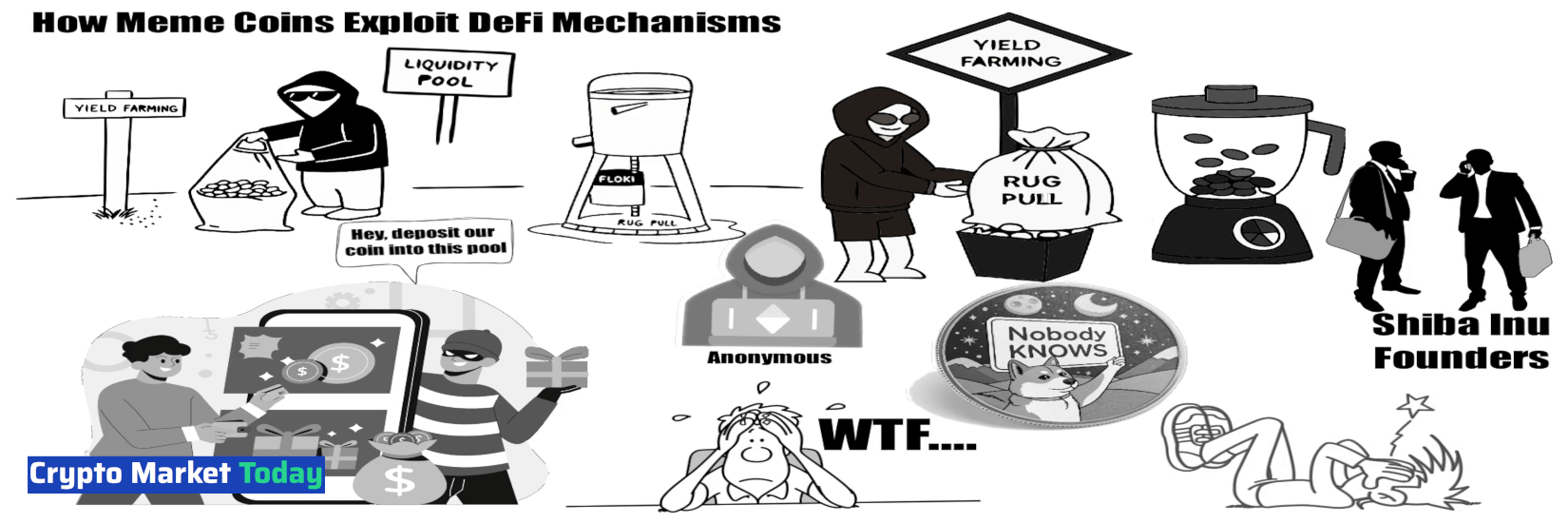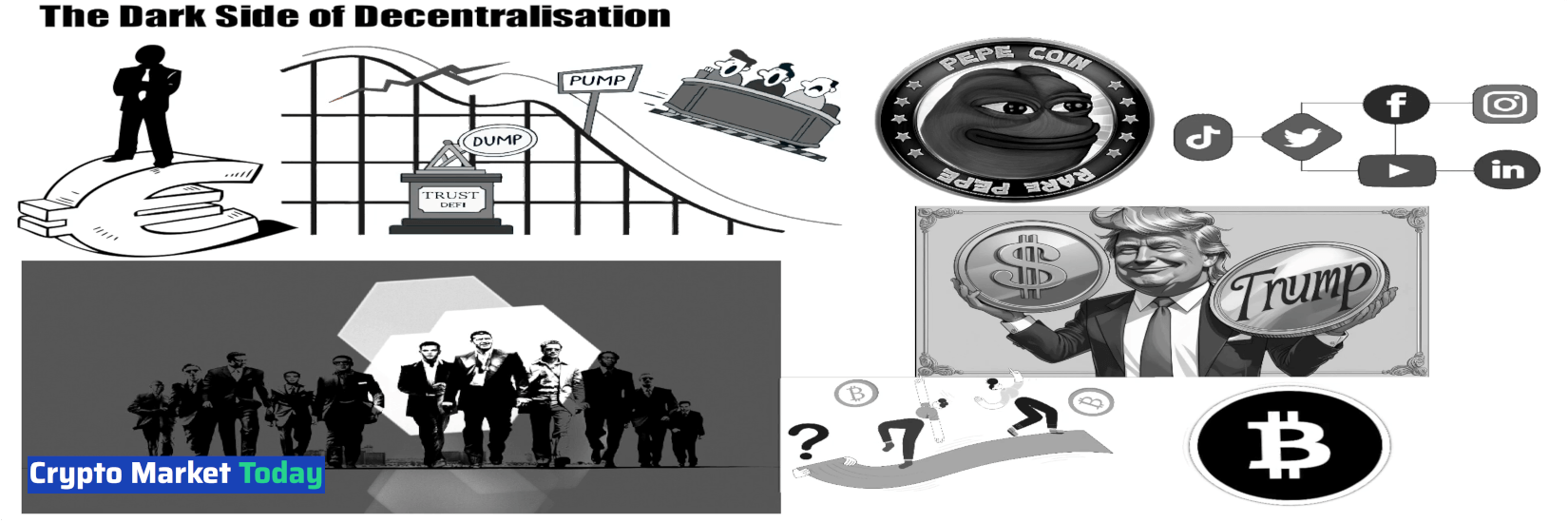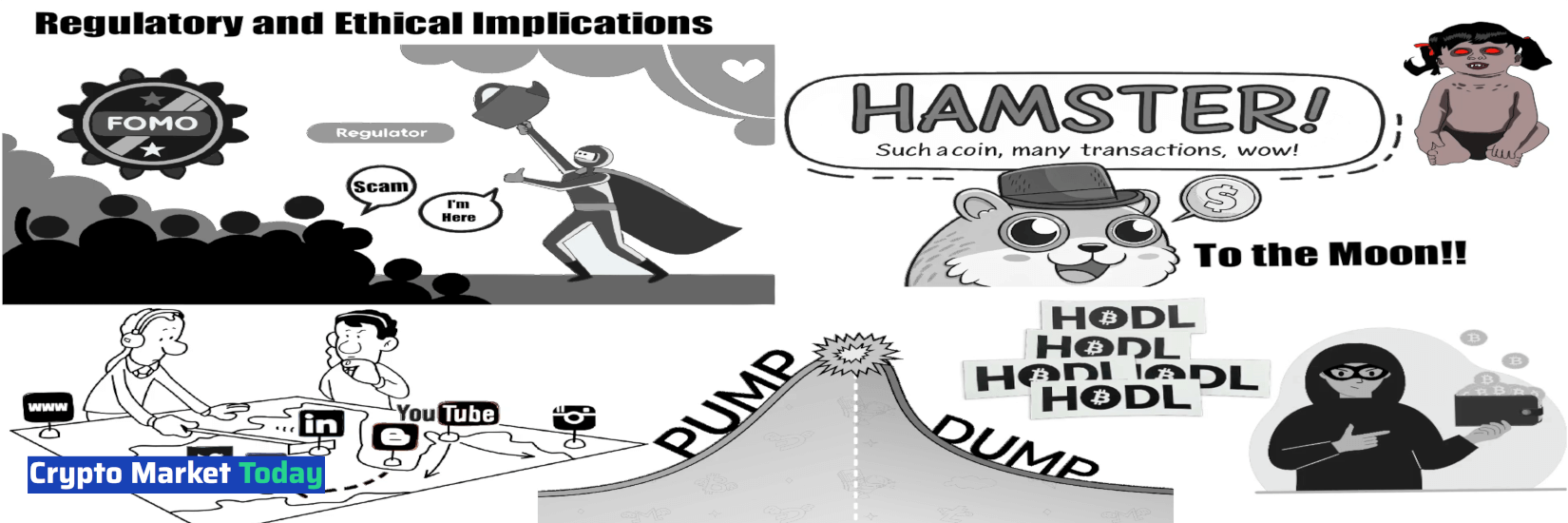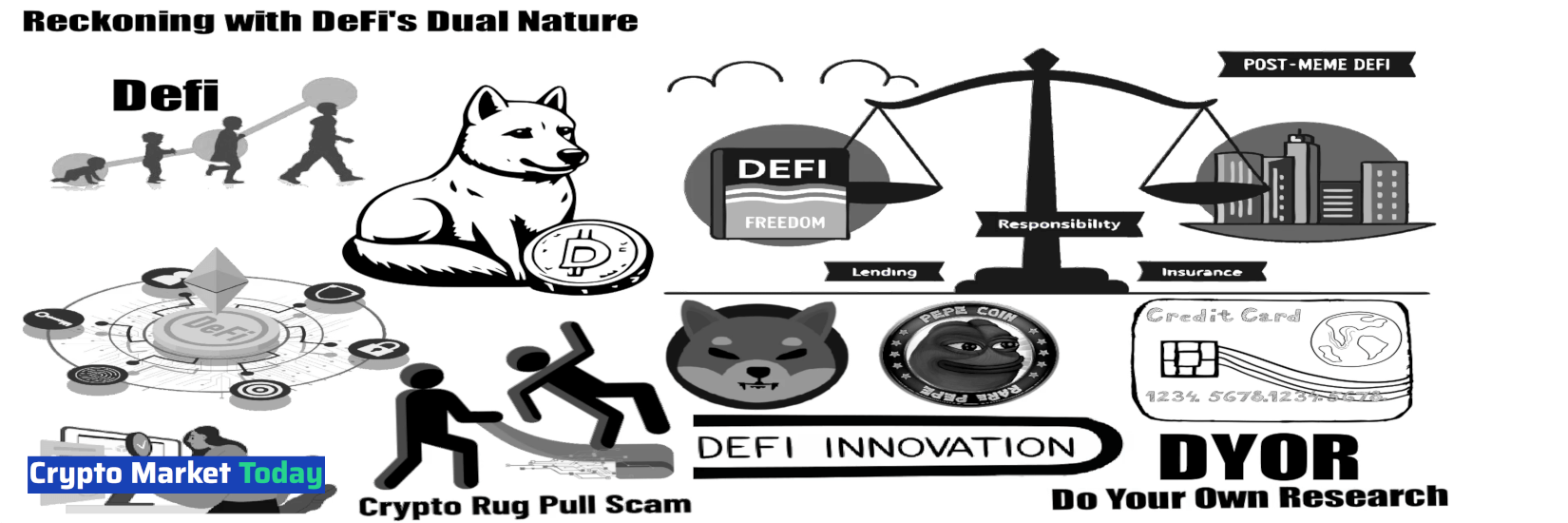TL;DR
The rise of meme coins like Dogecoin and Shiba Inu has exposed the darker underbelly of decentralized finance (DeFi). Initially created as internet jokes, these coins have evolved into speculative assets fueled by social media hype and DeFi mechanisms like liquidity pools and yield farming. While DeFi promised a transparent, equitable financial system, meme coins exploit its infrastructure to prioritize short-term gains over innovation. Anonymous creators leverage DeFi’s pseudonymous culture to launch "rug pulls" and pump-and-dump schemes, leaving retail investors with worthless tokens and eroding trust in the broader ecosystem.
Meme coins thrive on speculative frenzies, diverting resources and attention from meaningful blockchain projects. Their volatility destabilizes markets and attracts regulatory scrutiny, threatening DeFi’s decentralized ethos. Critics argue they distract from DeFi’s mission, while proponents claim they act as gateways for newcomers to explore crypto. However, the lack of accountability and rampant scams highlight systemic flaws in DeFi’s trustless model.
Regulators face a dilemma: curb predatory behavior without stifling innovation. Solutions may include transparency mandates, investor education, and ethical community guidelines. Ultimately, meme coins force a reckoning with DeFi’s dual nature—balancing freedom and responsibility. The future of decentralized finance hinges on addressing these challenges to reclaim its original vision of equitable, sustainable financial systems.
💻🔓🌐Introduction: Meme Coins and the Paradox of DeFi
The world of decentralized finance (DeFi) is often touted as a beacon of hope for equitable financial systems, where anyone can participate and benefit from global markets. However, beneath the surface of this utopian vision lies a dark side – the rise of meme coins. These internet-born cryptocurrencies have taken the market by storm, offering an explosive growth opportunity that's hard to resist.
What Are Meme Coins? From Joke to Market Force
Meme coins are a relatively new phenomenon in the crypto space. They originated as jokes or tongue-in-cheek projects, often created around popular memes or internet trends. The first notable example is Dogecoin, launched in 2013 as a light-hearted parody of Bitcoin. However, as social media platforms like Twitter and Reddit began to amplify their presence, meme coins started gaining traction.
In just a few short years, these joke coins have evolved into serious market players. They've exploded in value, often due to speculation and hype rather than any tangible underlying technology or utility. The most popular meme coins now boast enormous market capitalizations, making them seemingly legitimate investments for many retail investors.
However, this explosive growth raises questions about the true nature of these projects and their alignment with DeFi's original mission. While DeFi promised a transparent, decentralized, and accessible financial system, meme coins often subvert these principles through speculation and volatility.

💻🔓🌐 How Meme Coins Exploit DeFi Mechanisms 💻🔓🌐
The rise of meme coins has been a wild ride, with their popularity skyrocketing in recent times. However, beneath the surface of these seemingly harmless digital collectibles lies a darker reality – one where DeFi mechanisms are being exploited to fuel speculative frenzies and allow creators to evade responsibility.
Liquidity Pools and Yield Farming: Fueling Speculative Frenzies
DeFi tools like liquidity mining and automated market makers (AMMs) have made it incredibly easy for meme coin creators to proliferate their projects. These tools enable the creation of liquidity pools, which are essentially funds that are locked into a smart contract to facilitate trading on decentralized exchanges.
The problem lies in the fact that these liquidity pools often prioritize hype over utility. Meme coin creators can simply deposit their coins into a pool and reap the benefits of high-yield farming, without ever having to demonstrate any real value or use case for their project. This has led to a situation where speculative frenzies are fueled by the promise of quick profits, rather than any genuine interest in the underlying asset.
As a result, DeFi users are often left to navigate a complex and opaque ecosystem, with little regard for the actual utility or sustainability of the projects they're investing in. It's not uncommon to see meme coins being traded on decentralized exchanges, only to have their value plummet when reality sets in and investors realize that there's no underlying substance to back up the hype.
Anonymity and Lack of Accountability
DeFi's pseudonymous culture has also created a haven for meme coin creators to evade responsibility for scams or failed projects. Without any meaningful accountability measures in place, these individuals can create a project, dump it on unsuspecting investors, and then disappear with their gains – leaving the community to pick up the pieces.
This lack of transparency and accountability is particularly concerning, given the volatile nature of cryptocurrency markets. When investors are left without any clear recourse or protection, they're often forced to bear the brunt of losses that could have been avoided with more robust safeguards in place.

The Dark Side of Decentralization
Decentralized Finance (DeFi) was touted as a revolutionary solution to traditional banking's inefficiencies, promising transparency, security, and accessibility to financial services for all. However, the rise of meme coins has exposed a darker side to this decentralized system.
Pump-and-Dump Dynamics in a Trustless System
Meme coins have become notorious for their volatile nature and tendency to artificially inflate prices through coordinated manipulation. This is made possible by DeFi's trustless nature, which allows for anonymous transactions and the creation of complex financial instruments. The consequences are devastating:
• Rug pulls: Scammers drain millions from unsuspecting investors by creating a meme coin, only to abandon it and leave holders with worthless tokens.
• Coordinated price manipulation: Groups of traders manipulate prices through bots and social media hype, often targeting inexperienced investors who are lured in by promises of quick profits.
These dynamics not only damage the reputation of legitimate DeFi projects but also erode trust among users. The public perception of DeFi as a whole begins to suffer when scandals like these hit the headlines.
Erosion of Trust in DeFi Ecosystems
The impact on DeFi's ecosystem is far-reaching and damaging. When meme coin scandals attract regulatory crackdowns, it creates a ripple effect throughout the entire sector. Legitimate projects struggle to maintain credibility, and investors become increasingly cautious about participating in the space.
As the cryptocurrency market continues to grow and evolve, it's essential to acknowledge the darker side of decentralization. By understanding the vulnerabilities that meme coins have exposed, we can work towards creating a more robust and trustworthy DeFi ecosystem for all users. The time for transparency and accountability is now – or risk losing the trust that has been built upon.
💻🔓🌐Criticisms and Counterarguments
Meme coins have been a wild ride for the DeFi space, but beneath their flashy facades lies a complex web of controversies. Let's dive into two opposing viewpoints: Meme Coins as a Distraction from DeFi Innovation and Counterpoint: Meme Coins as a Gateway to DeFi.
Meme Coins as a Distraction from DeFi Innovation
The rise of meme coins has raised concerns that they're sucking up resources and attention away from meaningful blockchain advancements. Here are some arguments to consider:
• Resource Misallocation: The rapid growth of meme coin projects is diverting developer time and energy away from more innovative ideas, slowing down progress in the DeFi space.
• Market Instability: Meme coins' extreme price volatility can lead to market instability, making it challenging for investors to navigate and potentially damaging the reputation of the broader DeFi ecosystem.
• Decentralization Overload: With so many meme coin projects popping up, there's a risk of decentralization overload, where users become overwhelmed by the sheer number of options and lose sight of what truly matters – secure, reliable, and innovative financial tools.
Counterpoint: Meme Coins as a Gateway to DeFi
On the other hand, some argue that meme coins are actually introducing newcomers to the world of crypto and fostering broader adoption of DeFi tools despite risks. Here's why:
• Gateway to DeFi: Meme coins can serve as a gateway for new users to enter the DeFi space, exposing them to the possibilities of blockchain-based financial services.
• Increased Accessibility: By providing an alternative to traditional banking infrastructure, meme coins can increase accessibility to financial services, particularly benefiting underserved and unbanked populations.
• Broader Adoption: The popularity of meme coins can drive interest in more sophisticated DeFi tools, ultimately leading to broader adoption and a more vibrant ecosystem.
As this debate rages on, it's essential to acknowledge that both sides have valid points. While meme coins may be distracting from meaningful innovations, they also possess the potential to introduce newcomers to the world of crypto and foster broader adoption of DeFi tools. Ultimately, striking a balance between innovation and accessibility will be crucial in shaping the future of the DeFi space.

Regulatory and Ethical Implications
As the DeFi space continues to grow, regulatory bodies are faced with a daunting task: balancing the need to protect investors from potential risks while preserving the decentralized ethos that defines this innovative sector. The emergence of meme coins has brought new challenges to the table, and it's essential for governments to address these concerns without stifling innovation.
The Regulatory Dilemma: Curbing Abuse Without Stifling Innovation
Governments can take several steps to mitigate the risks associated with meme coins while maintaining DeFi's decentralized nature:
- Implementing clearer regulations that focus on protecting investors from fraud, tax evasion, and other malicious activities
- Encouraging transparency in cryptocurrency markets through real-time market data and trade reporting requirements
- Establishing guidelines for the issuance of new tokens, ensuring that they meet minimum standards for security and compliance
By taking a more nuanced approach to regulation, governments can promote innovation while safeguarding investors. This balance is crucial, as excessive oversight could stifle the growth of DeFi, hindering its potential to revolutionize the financial industry.
Ethical Questions in Community-Driven Speculation
The rise of meme coins has also raised concerns about predatory behavior targeting inexperienced investors through social media hype. Community-driven speculation can be a double-edged sword:
- On one hand, it fosters engagement and excitement around new projects
- However, it can also lead to herd mentality, where investors are swept up in the fervor without fully understanding the risks involved
As DeFi continues to evolve, it's essential to address these ethical concerns. This includes educating investors about the potential risks associated with meme coins and promoting responsible community engagement.
The intersection of regulatory oversight and community-driven speculation is a complex one. By acknowledging these challenges and working together, governments, regulators, and industry stakeholders can create a more robust and secure DeFi ecosystem that balances innovation with investor protection.

Conclusion: Reckoning with DeFi's Dual Nature
The rise of meme coins has served as a stark reminder that the decentralized finance (DeFi) ecosystem is not immune to flaws and pitfalls. While DeFi was initially envisioned as a utopian platform for financial freedom, the emergence of meme coins has exposed its darker side – one characterized by speculative frenzies, exploitation, and market instability.
Balancing Freedom and Responsibility
Meme coins have effectively exploited the DeFi system's weaknesses, exposing flaws in its utopian vision. The ease with which these tokens can be created, traded, and manipulated has led to a wild west of sorts, where investors are often left vulnerable to rug pulls, liquidity cannibalization, and other forms of exploitation. This scenario raises critical questions about the need for self-regulation and investor education within the DeFi community.
In order to reclaim its original purpose, DeFi must prioritize transparency, accountability, and responsible innovation. This requires a collective effort from developers, regulators, and investors alike to establish clear guidelines and best practices that promote sustainable growth and minimize risk. By doing so, DeFi can strike a balance between freedom and responsibility, ensuring that its benefits are accessible to all while mitigating the potential for harm.
The Future of DeFi in a Post-Meme Coin Era
As we move beyond the meme coin phenomenon, it is essential to consider whether DeFi can evolve beyond speculative frenzies to fulfill its original purpose. Can this ecosystem refocus on providing stable financial instruments, promoting innovation and collaboration, and delivering real-world benefits? The answer lies in the willingness of stakeholders to adapt, innovate, and prioritize long-term sustainability over short-term gains.
Ultimately, the future of DeFi depends on our collective ability to learn from past mistakes, address systemic vulnerabilities, and strive for a more equitable, transparent, and responsible financial ecosystem. By embracing this challenge, we can create a post-meme coin era where DeFi truly lives up to its promise – one that prioritizes freedom, responsibility, and the well-being of all participants.
In conclusion, the rise of meme coins has exposed some of the darker aspects of DeFi, including the exploitation of liquidity pools and yield farming mechanisms to fuel speculative frenzies. The lack of accountability and transparency in this space also raises serious concerns about the safety and security of investors. As the DeFi ecosystem continues to evolve, it's essential that we prioritize more robust safeguards and regulations to protect users from these types of risks. 💻🔓🌐